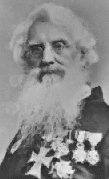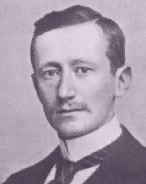|
|
|
1873
|
The British physicist James Clerk-Maxwell announces the theory of
electro-magnetic waves. |
 |
Samuel Morse. (1791 - 1872)
Morse was born in Charlestown, Massachusetts (now part of Boston), on
April 27, 1791, and educated at Yale College (now Yale University).
He studied painting in London and became a successful portrait painter
and sculptor. In 1825 he helped found the National Academy of Design in
New York City, and the following year he became the first president of
the institution. He continued his painting and became a professor of
painting and sculpture at New York University in 1832. About that time
he became interested in chemical and electrical experiments and developed
apparatus for an electromagnetic telegraph that he completed in 1836.
The following year he filed a caveat, or legal notice, at the patent
office in Washington, D.C., and tried without success to obtain European
patents for his apparatus. He also invented a code, now known as the
Morse code, for use with his telegraph instrument.
|
Microsoft (R) Encarta. Copyright (c) 1994 Microsoft Corporation.
Copyright (c) 1994 Funk & Wagnall's Corporation.
|
1888
|
Heinrich Hertz produces the first electro-magnetic waves by supplying an
electric charge to a capacitor and then short-ciruiting it. The energy
from the resulting spark is radiated in the form of electromagnetic
waves and Hetz is able to measure the wavelength and velocity of these
so-called Hertzian waves.
|
|
1894
|
British physicist Sir Oliver Lodge uses a device called the coherer to
detect the presence of radio waves and demonstrates that these waves could
be used for signalling.
|
|
1895
|
Marconi finally devises a practical apparatus for the purpose,
comprising an aerial, a condenser and a connection to earth.
|
|
1896
|
Marconi demonstrates his apparatus to the British authorities by
transmitting signals for more than 1 mile and he applies for his first
British patent.
|
|
1898
|
Wireless telegraphy is used for the first time in naval manoeuvres -
a range of 60 miles.
|
|
1899
|
Communication between England and France.
|
|
1901
|
Communication across the Atlantic.
|
|
1906
|
American inventor de Forest adds a third electrode to the diode
and produces a sensitive receiver and amplifier.
|
|
Guglielmo Marconi (1874 - 1937)
Italian electrical engineer, He was born in Bologna
and educated at the University of Bologna. As early as 1890 he became
interested in wireless telegraphy, and by 1895 he had developed apparatus
with which he succeeded in sending signals to a point a few kilometers
away by means of a directional antenna. After patenting his system in
Great Britain, he formed (1897) Marconi's Wireless Telegraph Company,
Ltd., in London. In 1899 he established communication across the English
Channel between England and France, and in 1901 he communicated signals
across the Atlantic Ocean between Poldhu, in Cornwall, England, and Saint
John's, in Newfoundland, Canada. His system was soon adopted by the
British and Italian navies, and by 1907 had been so much improved
that transatlantic wireless telegraph service was established for public
use. Marconi was awarded honors by many countries and received, jointly
with the German physicist Karl Ferdinand Braun, the 1909 Nobel Prize
in physics for his work in wireless telegraphy.
|
 |
Microsoft (R) Encarta. Copyright (c) 1994 Microsoft Corporation.
Copyright (c) 1994 Funk & Wagnall's Corporation.
|
1914
|
The thermionic valve is used as a radio generator which produces a
carrier wave capable of being modulated by speech. Marconi transmits
speech over 50 miles.
|

|
1915
|
A radio station in Arlington, USA, communicates with both Paris and
Honolulu.
|
|
1920
|
The rectifying properties of crystals, which means they could be used as
radio detectors, gives rise to the popularity of the crystal-set.
|
|
Today!
|
Immense developments in radio communication technology after World
War II helped make possible space exploration, most dramatically in
the Apollo moon-landing missions (1969-72) and communications satellites.
|
|


